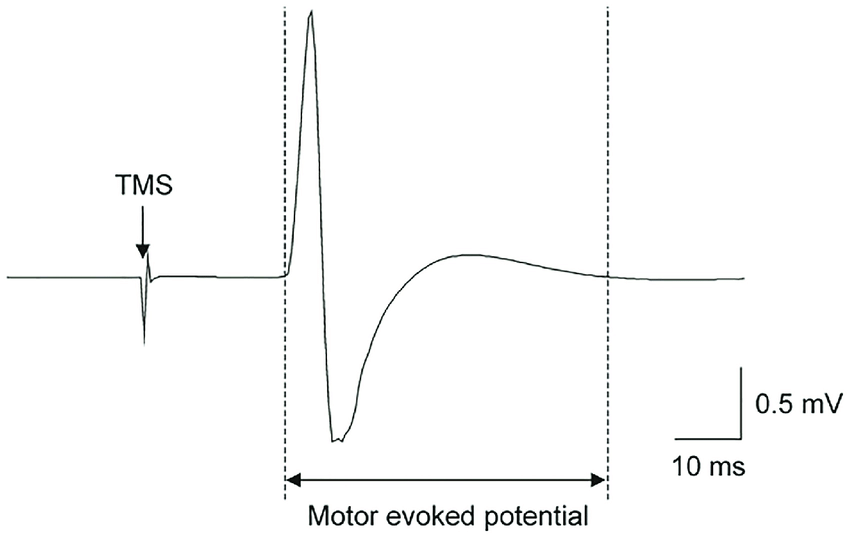[1]
Macdonald DB. Intraoperative motor evoked potential monitoring: overview and update. Journal of clinical monitoring and computing. 2006 Oct:20(5):347-77
[PubMed PMID: 16832580]
Level 3 (low-level) evidence
[2]
Buhl LK, Bastos AB, Pollard RJ, Arle JE, Thomas GP, Song Y, Boone MD. Neurophysiologic Intraoperative Monitoring for Spine Surgery: A Practical Guide From Past to Present. Journal of intensive care medicine. 2021 Nov:36(11):1237-1249. doi: 10.1177/0885066620962453. Epub 2020 Sep 28
[PubMed PMID: 32985340]
[3]
Jameson LC, Sloan TB. Monitoring of the brain and spinal cord. Anesthesiology clinics. 2006 Dec:24(4):777-91
[PubMed PMID: 17342964]
[4]
Macdonald DB,Skinner S,Shils J,Yingling C,American Society of Neurophysiological Monitoring., Intraoperative motor evoked potential monitoring - a position statement by the American Society of Neurophysiological Monitoring. Clinical neurophysiology : official journal of the International Federation of Clinical Neurophysiology. 2013 Dec
[PubMed PMID: 24055297]
[5]
Jones SJ, Buonamassa S, Crockard HA. Two cases of quadriparesis following anterior cervical discectomy, with normal perioperative somatosensory evoked potentials. Journal of neurology, neurosurgery, and psychiatry. 2003 Feb:74(2):273-6
[PubMed PMID: 12531970]
Level 3 (low-level) evidence
[6]
Deletis V, Sala F. Intraoperative neurophysiological monitoring of the spinal cord during spinal cord and spine surgery: a review focus on the corticospinal tracts. Clinical neurophysiology : official journal of the International Federation of Clinical Neurophysiology. 2008 Feb:119(2):248-64
[PubMed PMID: 18053764]
[7]
Cioni B, Meglio M, Rossi GF. Intraoperative motor evoked potentials monitoring in spinal neurosurgery. Archives italiennes de biologie. 1999 May:137(2-3):115-26
[PubMed PMID: 10349490]
[8]
GILLILAN LA. The arterial blood supply of the human spinal cord. The Journal of comparative neurology. 1958 Aug:110(1):75-103
[PubMed PMID: 13631126]
Level 2 (mid-level) evidence
[9]
de Haan P, Kalkman CJ. Spinal cord monitoring: somatosensory- and motor-evoked potentials. Anesthesiology clinics of North America. 2001 Dec:19(4):923-45
[PubMed PMID: 11778387]
[10]
Nunes RR, Bersot CDA, Garritano JG. Intraoperative neurophysiological monitoring in neuroanesthesia. Current opinion in anaesthesiology. 2018 Oct:31(5):532-538. doi: 10.1097/ACO.0000000000000645. Epub
[PubMed PMID: 30020157]
Level 3 (low-level) evidence
[11]
Lotto ML, Banoub M, Schubert A. Effects of anesthetic agents and physiologic changes on intraoperative motor evoked potentials. Journal of neurosurgical anesthesiology. 2004 Jan:16(1):32-42
[PubMed PMID: 14676568]
[12]
Wilent WB, Tesdahl EA, Trott JT, Tassone S, Harrop JS, Klineberg EO, Sestokas AK. Impact of inhalational anesthetic agents on the baseline monitorability of motor evoked potentials during spine surgery: a review of 22,755 cervical and lumbar procedures. The spine journal : official journal of the North American Spine Society. 2021 Nov:21(11):1839-1846. doi: 10.1016/j.spinee.2021.07.002. Epub 2021 Jul 15
[PubMed PMID: 34274500]
[13]
Chen Z. The effects of isoflurane and propofol on intraoperative neurophysiological monitoring during spinal surgery. Journal of clinical monitoring and computing. 2004 Aug:18(4):303-8
[PubMed PMID: 15779842]
[14]
Sloan T, Rogers J. Dose and timing effect of etomidate on motor evoked potentials elicited by transcranial electric or magnetic stimulation in the monkey and baboon. Journal of clinical monitoring and computing. 2009 Aug:23(4):253-61. doi: 10.1007/s10877-009-9190-z. Epub 2009 Jul 12
[PubMed PMID: 19597748]
[15]
Walker CT, Kim HJ, Park P, Lenke LG, Weller MA, Smith JS, Nemergut EC, Sciubba DM, Wang MY, Shaffrey C, Deviren V, Mummaneni PV, Chang JM, Mummaneni VP, Than KD, Berjano P, Eastlack RK, Mundis GM Jr, Kanter AS, Okonkwo DO, Shin JH, Lewis JM, Koski T, Hoh DJ, Glassman SD, Vinci SB, Daniels AH, Clavijo CF, Turner JD, McLawhorn M, Uribe JS. Neuroanesthesia Guidelines for Optimizing Transcranial Motor Evoked Potential Neuromonitoring During Deformity and Complex Spinal Surgery: A Delphi Consensus Study. Spine. 2020 Jul 1:45(13):911-920. doi: 10.1097/BRS.0000000000003433. Epub
[PubMed PMID: 32539292]
Level 3 (low-level) evidence
[16]
Stoicea N, Versteeg G, Florescu D, Joseph N, Fiorda-Diaz J, Navarrete V, Bergese SD. Ketamine-Based Anesthetic Protocols and Evoked Potential Monitoring: A Risk/Benefit Overview. Frontiers in neuroscience. 2016:10():37. doi: 10.3389/fnins.2016.00037. Epub 2016 Feb 16
[PubMed PMID: 26909017]
Level 3 (low-level) evidence
[17]
Kawaguchi M, Iida H, Tanaka S, Fukuoka N, Hayashi H, Izumi S, Yoshitani K, Kakinohana M, MEP Monitoring Guideline Working Group of the Safety Committee of the Japanese Society of Anesthesiologists (JSA). A practical guide for anesthetic management during intraoperative motor evoked potential monitoring. Journal of anesthesia. 2020 Feb:34(1):5-28. doi: 10.1007/s00540-019-02698-2. Epub 2019 Oct 19
[PubMed PMID: 31630259]
[18]
Rozet I, Metzner J, Brown M, Treggiari MM, Slimp JC, Kinney G, Sharma D, Lee LA, Vavilala MS. Dexmedetomidine Does Not Affect Evoked Potentials During Spine Surgery. Anesthesia and analgesia. 2015 Aug:121(2):492-501. doi: 10.1213/ANE.0000000000000840. Epub
[PubMed PMID: 26097987]
[19]
Sloan TB, Mongan P, Lyda C, Koht A. Lidocaine infusion adjunct to total intravenous anesthesia reduces the total dose of propofol during intraoperative neurophysiological monitoring. Journal of clinical monitoring and computing. 2014 Apr:28(2):139-47. doi: 10.1007/s10877-013-9506-x. Epub 2013 Aug 31
[PubMed PMID: 23996498]
[20]
Oro J, Haghighi SS. Effects of altering core body temperature on somatosensory and motor evoked potentials in rats. Spine. 1992 May:17(5):498-503
[PubMed PMID: 1621147]
[21]
Seyal M, Mull B. Mechanisms of signal change during intraoperative somatosensory evoked potential monitoring of the spinal cord. Journal of clinical neurophysiology : official publication of the American Electroencephalographic Society. 2002 Oct:19(5):409-15
[PubMed PMID: 12477986]
[22]
Davis SF, Altstadt T, Flores R, Kaye A, Oremus G. Report of seizure following intraoperative monitoring of transcranial motor evoked potentials. The Ochsner journal. 2013 Winter:13(4):558-60
[PubMed PMID: 24358008]
[23]
Burbridge MA, Nguyen V, Min JG, Jaffe RA, Ahuja B, Shah AD, Lee LH, Cho C, Sandoval B, López JR. Intraoperative Transcranial Motor-evoked Potential Stimulation Does Not Seem to Cause Seizures. Journal of neurosurgical anesthesiology. 2021 Oct 1:33(4):351-355. doi: 10.1097/ANA.0000000000000671. Epub
[PubMed PMID: 31876633]
[24]
Duma A, Novak K, Schramm W. Tube-in-tube emergency airway management after a bitten endotracheal tube caused by repetitive transcranial electrical stimulation during spinal cord surgery. Anesthesiology. 2009 Nov:111(5):1155-7. doi: 10.1097/ALN.0b013e3181b8f694. Epub
[PubMed PMID: 19809290]
[25]
Jain R, Sethi N, Sood J. Loss of integrity of a reinforced endotracheal tube by patient bite. Indian journal of anaesthesia. 2013 Jul:57(4):424. doi: 10.4103/0019-5049.118520. Epub
[PubMed PMID: 24163469]
[26]
Anwer M, Manzoor S, Muneer N, Qureshi S. Compliance and Effectiveness of WHO Surgical Safety Check list: A JPMC Audit. Pakistan journal of medical sciences. 2016 Jul-Aug:32(4):831-5. doi: 10.12669/pjms.324.9884. Epub
[PubMed PMID: 27648023]

